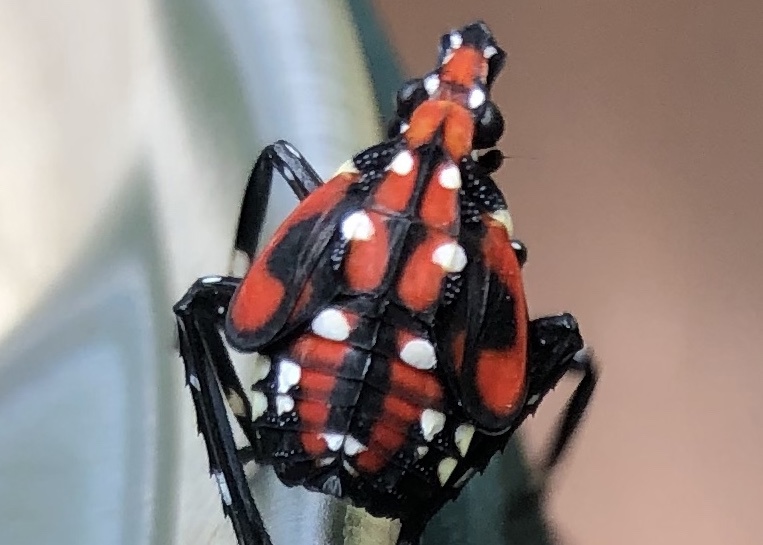Spotted Lanternfly Lycorma delicatula

Spotted Lanternfly Identification
Color: Red, black and light brown with white and black spots
Size: Adults are approximately 1” long ½” wide at rest
Legs: 6
Antennae: No
Shape: Circular or oval-shaped at rest; have two pairs of wings creating butterfly-like appearance when spread
Region: Pennsylvania, New Jersey, Delaware and Virginia
What is a Spotted Lanternfly?
The Spotted Lanternfly is a relatively new invasive species to the United States. Native to Asia, namely China, India and Vietnam, the spotted lanternfly was first documented in the U.S. in 2014, in Berks County, Pennsylvania. It is now considered an invasive species throughout southeastern Pennsylvania, southwestern New Jersey, northern Delaware and northern Virginia. They are a huge threat to agriculture throughout the areas they invade. Keep reading to learn more, including information on pest control and how to get rid of the spotted lanternfly.
Identification
Spotted lanternflies get their name from the distinguishable black spots on their front wings as adults. Adult SLF have spotted forewings that cover brightly-colored hind wings. Spotted lanternfly nymphs are usually 1/8 to 1/2 inch in size with white-spotted, black bodies changing to bright red coloration in older nymphs. Adults are larger than nymphs, around 1 inch in length and an inch and a half wide when wings are spread. The adults are typically easier to find because of their size, coloration, and increased mobility.
Spotted lanternflies are a type of planthopper and although they have wings, they only fly short distances and primarily jump or walk. Spotted lanternflies lay their eggs in the fall and hatch in the spring. They lay their eggs on hard surfaces, such as homes, trees, rocks, etc. and lay an average of 30-50 eggs at a time. Spotted lanternflies go through several stages as an immature nymph, in which they grow wings and change color. Adult spotted lanternflies emerge in the summer and their entire lifespan usually lasts around one year. Spotted lanternflies feed on both woody plants and non-woody plants, including trees and a variety of plant species.
Spotted lanternflies’ preferred host to feed and mate on is the tree-of-heaven (Ailanthus altissima), an invasive plant first introduced to the Philadelphia-area in the 18th century. However, they have been known to host on over 70 other plant species and will lay eggs just about anywhere.
Spotted lanternflies do not bite or sting humans, but they are a major destructive pest. They are a huge agricultural threat to plants and trees such as grapes, hops and hardwoods, causing costly damage. They are also a nuisance and can affect the quality of life in the areas they invade because they are a nuisance and will congregate in large numbers. Spotted lanternflies harm their host plants by feeding on the plant’s sap, leading to weeping wounds of sap and mold, which can result in stunted growth or even plant death.
Homeowners are encouraged to help stop the spread of spotted lanternflies by checking cars and any outdoor equipment, like grills, firewood and lawnmowers, when traveling in and out of the quarantined zones. If you find an infestation on your property, there are a number of spotted lanternfly control methods to manage the invasion, including:
- Scraping any visible egg masses off of trees and properly destroying them
- Removing the tree-of-heaven if there are any growing on your property
- Banding trees where spotted lanternflies are detected
- When there are only a few insects, you can kill spotted lanternflies by swatting or crushing them
- Consult with a pest control professional specializing in SLF treatment
Areas affected by spotted lanternfly populations are currently working to stop the spread and damage caused by this invasive pest. Fourteen counties throughout southeastern Pennsylvania are currently under a quarantine, put in place by the PA Department of Agriculture to regulate the movement of plants and other items spotted lanternflies can be hosting on, in and out of the quarantined areas. They are also routinely removing spotted lanternflies’ favorite host, the tree-of-heaven.
For help getting rid of spotted lanternflies contact a licensed pest control professional. You can find one near you with the helpful zip code search below.




